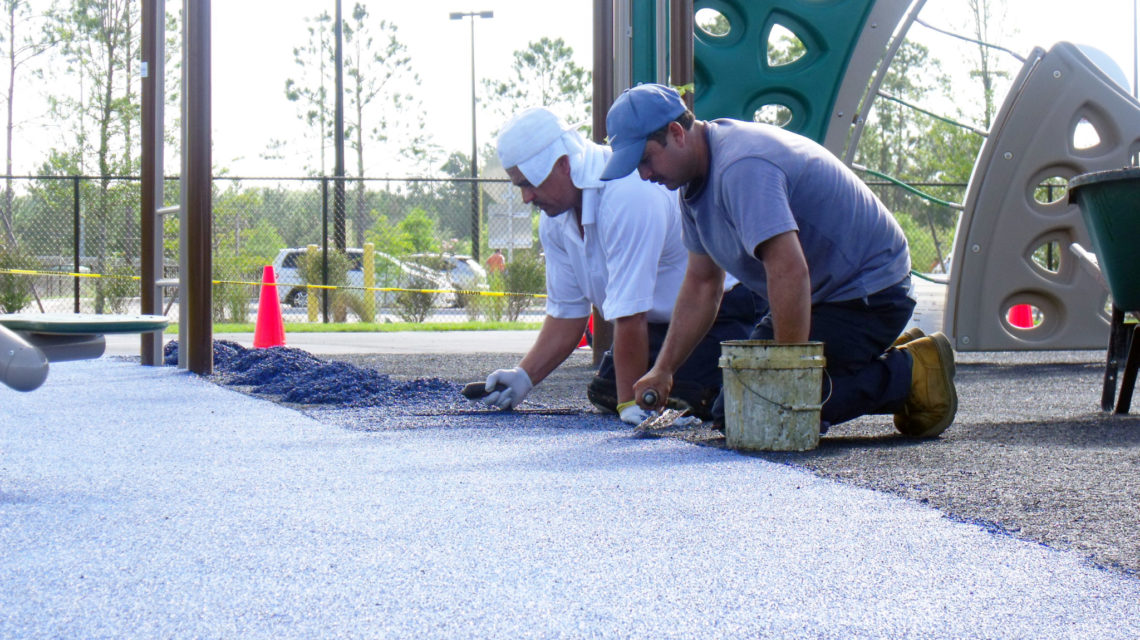When it comes to poured in place rubber, a good binder is everything. You must test your binders before you use them on large applications, and always do a small test sample of the binder prior to installation to make sure it will react with temperatures in the manner you expect to avoid hyper curing.
The most important ingredient in any poured in place rubber playground surface is the binder. The binder, also referred to as resin is literally the glue that holds the entire surface together and in its place. There are a number of companies that produce and import urethane based binders and resins for use with poured in place rubber. Using a sub-par binder will result in a poured in place rubber surface that falls apart and fails prematurely.
Aromatic Poured in Place Rubber Binders
Aromatic binders are the most widely used binders for poured in place rubber surfacing. There specific ingredients are typically a proprietary blend that is known only to the manufacturer. A good aromatic binder will be custom tailored to meet the installers needs, most importantly the environmental conditions present during installation, i.e. specific heat and humidity levels. Most companies will have two or more different types of aromatic binders, usually known as a summer binder and a winter binder. Winter binders are designed to cure faster, since temperatures and humidity are generally low. Summer binders will have a catalyst added to them to increase curing times. Both winter and summer binders are moisture cured, so both will react with direct exposure to water, with some binders this reaction can be devastating, with the formation of a foam known as poly urea. Poly urea will destroy the finished look of a poured in place rubber surface, and cannot be repaired without removing the surfacing entirely. Aromatic binders are caramel in color, and can range from opaque to milky. When aromatic binders cure, and are exposed to UV rays, the develop a yellowish tint. This yellowish tint will also vary greatly among different brands of binder. In general the tint will lessen and dissipate over the first few months after installation. Because of this tinting effect, it is recommended that you only use darker colors with aromatic binders, lighter shades of colors and whites will look a very unattractive yellow when combined with an aromatic binder that has cured. Aromatic binders will degrade over time with UV exposure. Because of this, it’s crucial to use a binder that has UV stabilizers added to it. This will greatly increase the life of the finished poured in place rubber surface.
Aliphatic Binders
Aliphatic binders are also common place in the poured in place rubber industry. Aliphatic binders are also urethane based, but are entirely clear and will remain so after curing. Aliphatic binders are a much more purified binder than aromatic binders. Because of this they are far more stable during installation and also tend to create a surface that is more resistant to UV and in general will outlast a comparable surface made with an aromatic binder. Aliphatic binders are about three times more expensive per gallon than aromatic binders, because of this they are generally only used in situations where lighter colors are used, or in areas with heavy traffic and standing water, like pools, commercial entrance ways and water parks.
Regardless of what binder is used, quality of the binder and conditions during installation will determine the finished poured in place rubber product and how long it will last. Even the best binder will fail if it is used under the wrong conditions that cause hyper curing. Hyper curing of a poured in place rubber surface occurs when heat and humidity levels cause the poured in place rubber surface to cure and harden in less than an hour as opposed to the normal 14-24 hour window. When hyper curing occurs, we have two devastating things that happen. The first is that it makes it very difficult to trowel away seams and create a uniform surface, in fact it’s nearly impossible. The second thing that happens is that we get a very poor bond strength as a result of the hyper curing, the end result is a surface that will degrade very quickly.

